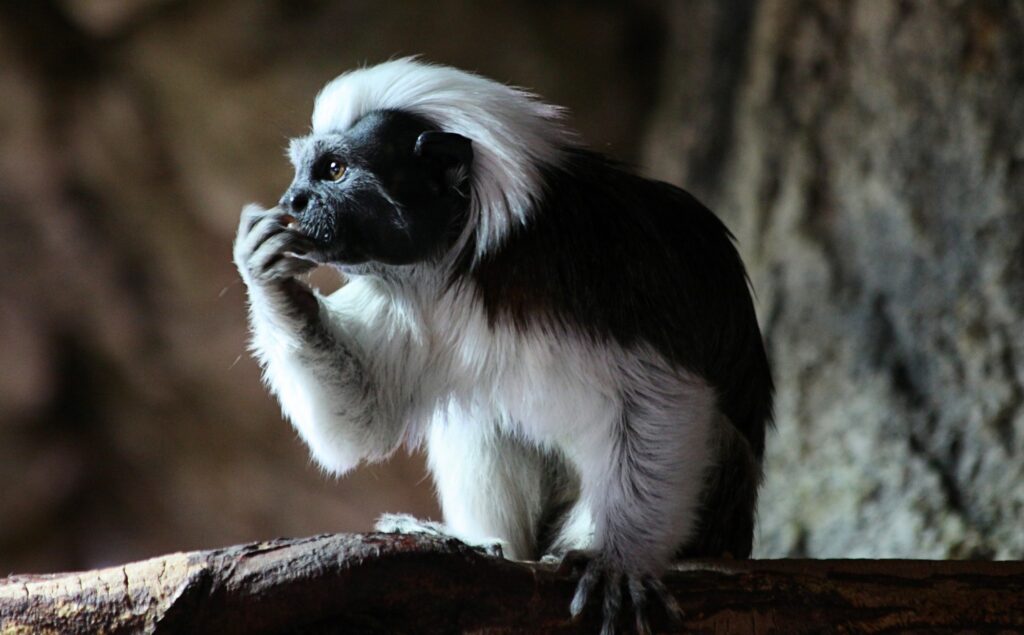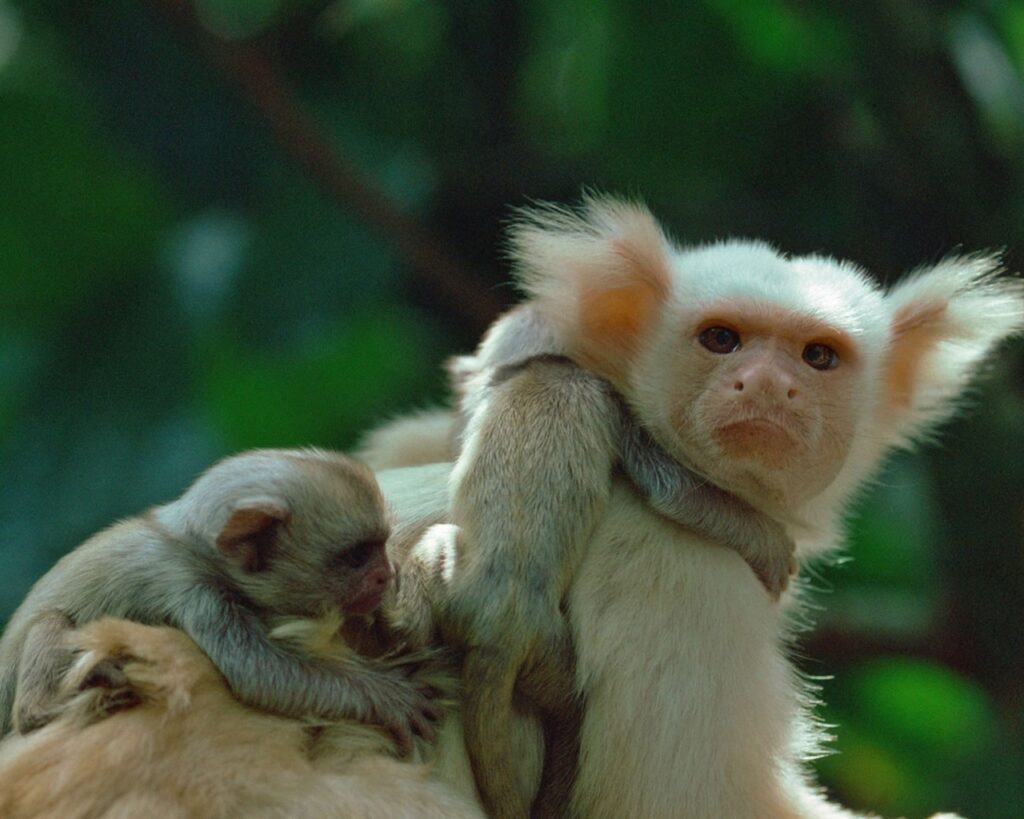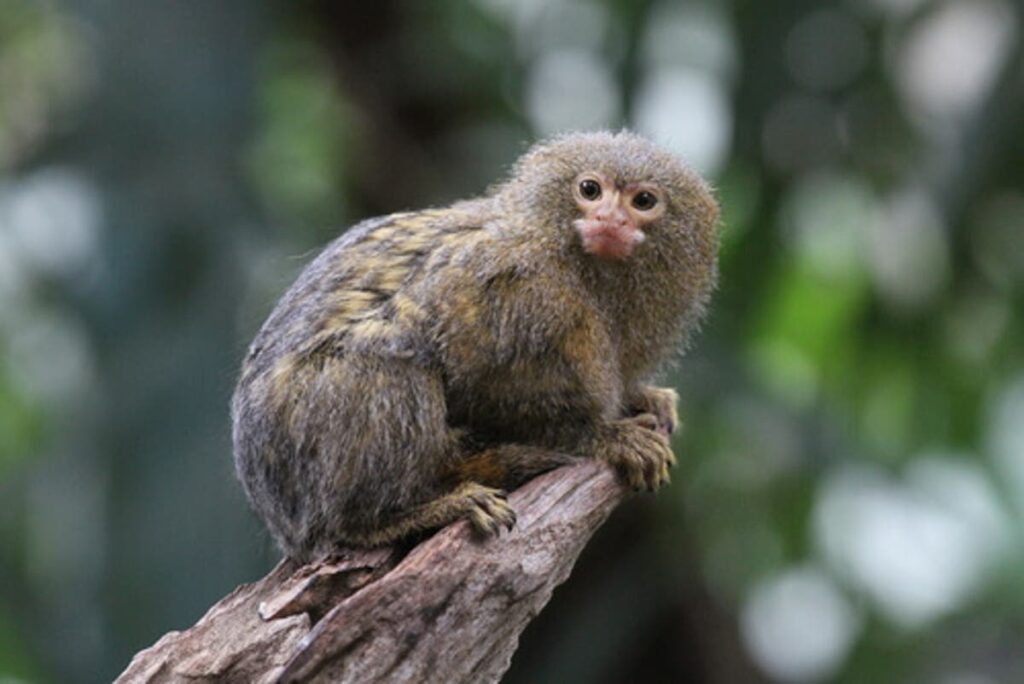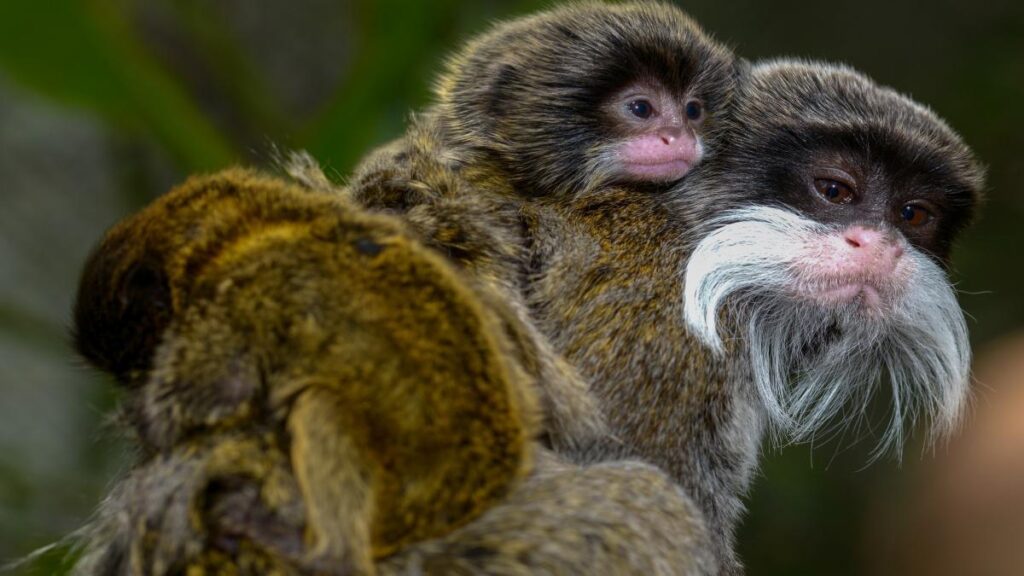The Tití Monkey is a small primate that inhabits the leafy forests of Central and South America. It is of diurnal habits and notably arboreal, since it prefers thick forests near water. There is considerable variation in weight and size between different species of this ape. To learn more about this curious monkey, I invite you to continue reading.
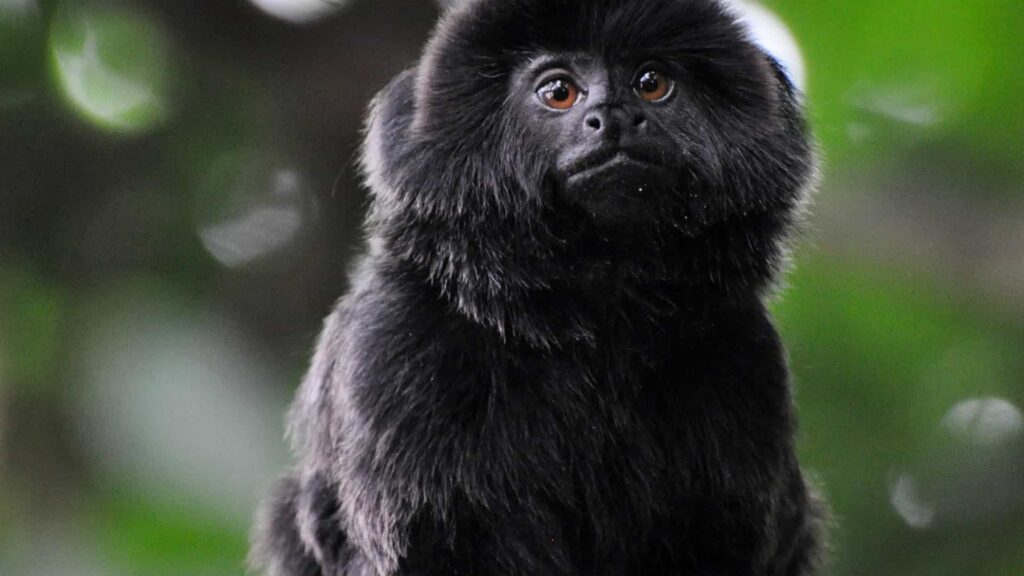
The Titi Monkey
The marmoset monkey is a variety of tropical monkey that is found in Central and South America and is popularly known as the pocket monkey. Marmoset is the common denomination of different species of American apes (platyrrhines), which are part of the Callitrichidae family.
The callitrichidae (Callitrichidae) constitute a family of platyrrhine primates that inhabit Central and South America, which includes some 42 species frequently named marmosets and tamarins. In the publication called Mammal Species of the World (MSW) it is estimated at this group as a subfamily (Callitrichinae) of the family Cebidae.
In addition to being one of the best known and most frequent primates, they are considered very capable of adapting to the alterations caused by humans in their natural habitat. The marmoset monkey is a creature of great charisma and easy to deal with. Today it is estimated that there are more than 40 varieties of small monkeys, also referred to as callitrichids or other species called tamarins.
Characteristics of the Titi Monkey
The weight of marmosets is between 100 (C. pygmaea) and 800 grams (Loentopithecus), while their body length is between 13 (C. pygmaea) and 50 centimeters (Leontopithecus) and their tail extends for about 15 or 40 centimeters. They exhibit two molars on each side of the upper jaw (with the exception of Callimico), on the other hand their tail is not prehensile and they have opposable thumbs.
They are small creatures, with delicate, silky fur; some varieties have tufts of extensive hair on the ears and on the cheeks. Its fur has a black and white color, its head shows a rounded shape. The teeth of the different varieties of marmoset monkey can loosen the bark of the trees, and thus suck their sap. They have diurnal habits and are eminently arboreal and the claws they have, instead of nails, allow them to hold on to the branches of the trees perfectly.
Marmosets live in their territories and are usually found in small aggregations of about 5 to 6 individuals. These groups defend their space, scaring away intruders with screams and threatening chases. Sometimes groups of different varieties of monkeys are linked. Grooming and communication have a prominent place in cooperation between groups. They are usually seen in pairs sitting or dozing.
They are one of the few apes that experience multiple births, usually twins, in up to 80% of the varieties studied. In contrast to most primates, males play an outstanding role in parental care, sometimes even more so than females.
Family groups are regularly made up of a couple and their children, who in turn are part of territorial groups. The mother is the one in charge of the upbringing despite the fact that in the group there may be several adult daughters of childbearing age. All those who make up the group lend their help for the care of the young people.
Food
The food of the marmoset monkeys is composed particularly of fruits, leaves, flowers, nectar, fungi, sap, latex, resin and rubber among other plant components. They also tend to feed on insects, lizards, spiders, snails, tree frogs, chicks, bird eggs and modest vertebrates. At least 15% of their diet comes from gum trees.
Reproduction
Although female marmosets can mate with more than one male, matings are often monogamous, that is, with the same partner, even for life. Its gestation period is about 5 months, with the female regularly having just one offspring. The link between the father and the offspring is very powerful, since he is the one who is responsible for the baby, and only takes it with the mother for the purposes of breastfeeding or other care. The rest of the members of the family group usually help in raising the baby monkey.
At 5 months, the young are no longer suckled and they fully develop when they are over a year old. After 2 to 3 years they separate from the family group in order to find a partner. His life expectancy is considered to be 12 years.
Habitat of the Titi Monkey
Members of the family are located in Central and South America (Colombia, Bolivia, Brazil, Peru and Paraguay). They can subsist in fields, coastal forests, moist Atlantic coastal forests and in semi-deciduous forests.
In Costa Rica two subspecies or races are known. The one that is under greatest threat is located in the areas of Parrita, Quepos and Potrero Grande in Buenos Aires. The other subspecies is located in the south of the country, primarily in the Osa. It is common to see them in the Manuel Antonio National Park, Quepos and the forests near Puerto Jiménez on the Osa Peninsula.
Its habitat is located in cool forests, primarily in leafy undergrowth. Much of their time is spent in the treetops. They populate thick jungles like those of the Amazon River. Only a few varieties, such as the Black Ashy Marmoset, are frequently seen only from Brazil.
Dangers you face
Most marmosets are considered a threatened species, particularly due to the devastation of their habitat. Its greatest threat is the desolation of the forest, since it reduces its territory to feed and reproduce. They are curious species for those who seek to have animals in captivity. This variety is protected by what is stated in Appendix I of the Convention for Trafficking in Endangered Species (CITES).
Classification
According to Rylands and Mittermeier (2009), callitrichids include 7 genera (Calibella, Cebuella, Callimico, Callithrix, Mico, Leontopithecus and Saguinus) made up of 42 species. In 2010, Mico rondoni was recognized as a species, to which previously considered as a subspecies part of Mico emiliae. In 2014, it was discovered that Mico manicorensis was a similar of Mico marcai.
According to Garbino and Martins-Junior (2017), callitrichids include the genera Callithrix, Cebuella, Mico, Saguinus, Leontopithecus and Callimico. These authors, in turn, subdivide the genus Saguinus into three subgenera: Saguinus, Leontocebus and Tamarinus.
The marmoset monkeys are usually divided into five different groups: the true marmoset, the tamarin (also called the moustached or pinchés marmoset), the pygmy or small marmoset, the lion marmoset (also named the golden or leonine marmoset) and the Goldi's tamarin, that still maintains 3 molars in each hemijaw.
Types of Marmoset Monkey
The marmoset is the common denomination of platyrrhine primates of the callitrichid family that are only found in Central and South America. Here are some details of the types of marmoset monkeys.
Cotton-headed Marmoset
The cotton-top tamarin (Saguinus oedipus) is also known as the white-headed tamarin, red-skinned tamarin, or cottony tamarin, among many other names. This beautiful animal is part of the genus Saguinus and is distributed throughout various regions of Colombia.
Its size is tiny, weighing about 500 grams, and its body plus tail barely reaches a length of 37 centimeters. Its diet consists of insects, ripe fruits, sap and nectar. It is classified as in a critical state of conservation, despite the fact that some Colombian institutions are fighting to save this wonderful marmoset, creating forest sanctuaries and conservation programs for this species.
Genus Cebuella
The pygmy marmoset (Cebuella pygmaea) is the smallest among the 42 species. Unfortunately for us, it is coveted by pet traffickers due to its beauty and relative docility. This marmoset is the only representative of the genus Cebuella. Its size is about 14 to 18 centimeters, to which is added the non-prehensile tail that exceeds the length of the body. Their diet consists of the sap of some plants, fruits and insects. Sometimes it even feeds on lizards.
It exhibits a very striking coat mottled with black, yellowish and orange tones. His head is decorated with a kind of bushy mane. For this reason it is also known as the lion tamarin. It is not considered threatened yet, despite the fact that its decrease has been evidenced. It lives in the upper Amazon, comprising the following nations: Colombia, Ecuador, Peru, Bolivia and Brazil.
Genus Callimico
Goeldi's monkey, (Callimico goeldii), is the only representative of the genus Callimico. It resides in a very limited region of the Upper Amazon, with specimens found in Colombia, Peru, Bolivia, Ecuador and Brazil. Its length is about 30 centimeters plus its long tail that exceeds the length of its body.
Its weight ranges between 400 and 680 grams. Its coat is soft and dense throughout the body, except for the belly, which is very sparse. Its color is shiny black. Their diet consists of sap, nectar, insects and fungi. It is under threat, as it is hunted to be kept as a pet.
Genus Leontopithecus
This genus is made up of 4 varieties: pink lion tamarin; golden-headed lion tamarin; black lion tamarin and black-faced lion tamarin. All of these varieties are highly endangered. The black-faced lion tamarin (Leontopithecus caissara) is considered critically vulnerable. It is common in Brazil and its entire body is covered by a thick golden-copper mantle, except for its face, tail, arms and hands, which are black.
Genus Callithrix
The Genus Callithrix is composed of 6 species: common marmoset; black-eared tamarin; black brush tamarin; buff-headed tamarin; white-eared tamarin and Geoffroy's tamarin. Most of these varieties are endemic to Brazil, and are under threat. Geoffroy's marmoset, (Callithrix geoffroyi), also called the white-headed marmoset, is the most preferred marmoset as a pet, since there are breeding grounds for this species. It is not under threat.
This variety is endemic to Brazil, specifically to the departments of Minas Gerais, Rio de Janeiro and Espírito Santo. Its length is about 24 centimeters, to which must be added the tail that measures little more than the body length. It is a wonderful species, since its mantle is mottled with various shades of black, gray, white and orange. His face is adorned with white hair and plumes stand out on his ears.
Genus Mico
The genus Mico is made up of 14 species: silvery marmoset; white marmoset; black-tailed tamarin; Marmoset Brand; Snethlange's marmoset; black-headed tamarin; Manicore marmoset; Acari marmoset; tassel-eared tamarin; Aripuana marmoset; Rondon marmoset; gold and black marmoset; Maues tamarin and white-faced tamarin.
The silvery marmoset (Mico Argentatus) gathers in groups of 6 to 10 individuals. Only the dominant female has the right to reproduce, since she releases a pheromone that makes it impossible for other females to ovulate. Its length is about 18 to 28 centimeters and its weight varies from 300 to 400 grams. It is not under threat. It dwells in western Brazil and eastern Bolivia. Their diet is based on eggs, insects, fruit, sap and reptiles.
Black-tailed Marmoset
The black-tailed tamarin, (Mico melanurus) is part of the genus Mico. It is the southernmost of all marmosets, since it is distributed in southern Brazil, the Paraguayan Chaco, and eastern Bolivia. It is not under threat. Its length is about 22 centimeters plus the 25 of its tail. Its weight averages 380 grams. It has a brown back speckled with white on its body, delimited on both sides by whitish stripes. Its voluminous tail is black.
Genus Saguinus
This genus is the most abundant among the tamarins, since it is made up of 15 varieties: bald tamarin; baby milk monkey; Panamanian tamarin; emperor tamarin; marbled tamarin; lipped tamarin; gray marmoset; Martins Tamarind; white-mantled tamarin; blond-handed tamarin; mustachioed tamarin; black tamarin; black-necked tamarin; cotton-top tamarin and golden-mantled tamarin.
The emperor tamarin (Saguinus imperator) inhabits the Bolivian, Peruvian and Brazilian Amazon. His immense mustache is what gave him the name at the time, since it recalled the typical mustache of the German Emperor William II. Its body reaches up to 30 centimeters, to which is added the non-prehensile tail of about 40 centimeters. Some specimens can have a weight of up to 500 grams. Their diet consists of sap, fruits, insects, modest vertebrates, eggs, flowers and leaves. It is not under threat and 2 subspecies are known.
Other interesting articles are:
